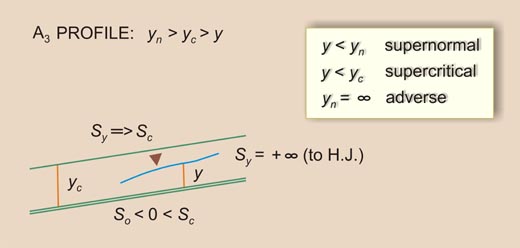online_wsprofiles_36: A3 water-surface profile
|
|
DESCRIPTION
-
General
- The php script [program] online_wsprofiles_36 calculates a A3 water-surface profile in a prismatic open channel using the direct-step method (Chow, V. T.: Open-channel hydraulics, McGraw-Hill, 1959).
- The program calculates critical depth downstream based on the geometric and hydraulic input data. Based on the critical depth, the program calculates critical slope (see onlinechannel04). If requested [by default], the program calculates normal depth in the upstream channel. Newton's iteration is used to solve the nonlinear equations.
- An A3 profile is supernormal, supercritical, and the bottom slope
is adverse (to the flow; i.e., negative) (see figure).
The calculated gradually varied flow depth varies between the specified flow depth
at the upstream boundary [or, if requested, the calculated normal depth for the upstream channel]
and [the flow depth increases toward] critical depth downstream.
Input - There are five required input variables: discharge Q, bottom width B, side slope z, Manning's n, and bottom slope So. The bottom slope must be negative (Example: So = -0.001).
- For the upstream boundary condition, you can specify a suitable input flow depth. Alternatively, if the input flow depth box is left blank, the program will use normal depth [in the steeper upstream channel] instead.
- To calculate normal depth in the upstream channel, the program requires additional input: discharge Q, bottom width B, side slope z, Manning's n, and bottom slope S in the upstream channel. If any of the first four values (Q, B, Z, or n) are the same as for the downstream channel, you can leave them blank. However, the program requires that you specify the bottom slope S in the upstream channel.
- The program echoes the input data. Internally calculated normal depth upstream is echoed with five-decimal (5) accuracy.
Defaults - For the input flow depth, you can enter any suitable supercritical supernormal flow depth. The allowable range of input flow depth is the following: Greater than [or equal to] normal depth [upstream], and less than the calculated critical depth downstream. Leave this box blank if you want the program to use normal depth upstream.
- You can enter the desired number of computational intervals n. The suggested range is 50-200. A higher number means higher computational accuracy. Leave this box blank if you want the program to set the default value at 100.
- You can enter the desired number of tabular output intervals m. The suggested range is 10-100. A higher number
means more detailed [longer] output.
Leave this box blank if you want the program to set the default value at 10.
Output - A table with fourteen (14) columns: output interval index k, [flow] depth (m), [flow] area (m2), velocity (m/s), velocity head (m), specific head (m), wetted perimeter (m), hydraulic radius (m), friction slope (m/m), average [friction] slope (m/m), specific head difference (m), length increment (m), depth gradient (m/m), and total [channel] length (m).
- The number of computational intervals n and the number of tabular output intervals m are printed for reference.
- The Froude number of the upstream flow is printed for reference.
- The critical depth and critical slope [in the adverse channel] are printed for reference.
Units - The current version is written in SI [metric] units.
Errors - Enter only a positive [nonzero] number for discharge. Failure to do this will trigger an error message and halt execution (Error message No. 1).
- Enter only nonnegative [zero or greater] numbers for bottom width and side slope. Failure to do this will trigger an error message and halt execution (Error messages No. 2: A and B, respectively).
- Bottom width and side slope cannot be zero at the same time. Failure to do this will trigger an error message and halt execution (Error message No. 3).
- A Manning's n value outside of the range 0.008-0.1 will trigger an error message and halt execution (Error message No. 4).
- Enter only nonnegative numbers [zero or greater] for discharge, bottom width, side slope, Manning's n and bottom slope
in the upstream channel.
Failure to do this will trigger an error message and halt execution (Error messages No. 5: A, B, C, D, and E, respectively).
Caution: Do not specify an [actual] zero upstream bottom width Bu/s (a triangular cross section) when the downstream channel bottom width B is other than zero. Likewise, do not specify an [actual] zero upstream size slope zu/s (a rectangular cross section) when the downstream channel side slope z is other than zero. In either case, the upstream values will be redefined as equal to the specified nonzero downstream values.
- A zero upstream bottom slope will trigger an error message and halt execution (Error message No. 6).
- A non-negative value for bottom slope will trigger an error message and halt execution (Error message No. 7).
- A value for bottom slope outside of the range (0 > bottom slope > -0.1) will trigger an error message and halt execution (Error message No. 8).
- An input flow depth less than the calculated normal depth upstream, or greater than or equal to the calculated critical depth downstream will trigger an error message and halt execution (Error messages No. 9: A and B, respectively).
- An upstream normal-depth Froude number less than 1.01
will trigger an error message and halt execution (Error message No. 10). May correct by increasing upstream bottom slope.
Thank you for running online_wsprofiles_36. Please call again. [Version 1.0.0, 070510]
